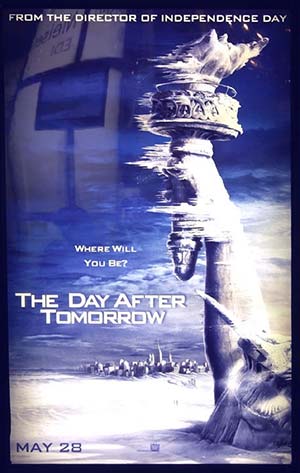 With The Day After Tomorrow, director Roland Emmerich’s generously subsidized odyssey to discover the tropospherically-high boredom threshold of the movie-going public has reached a level that would cause the eyes of Scheherazade herself to droop from two doors down.
With The Day After Tomorrow, director Roland Emmerich’s generously subsidized odyssey to discover the tropospherically-high boredom threshold of the movie-going public has reached a level that would cause the eyes of Scheherazade herself to droop from two doors down.
The German-born Emmerich – who may be his country’s revenge on America for bottled soda and the ensuing tooth decay – once again displays the same fumble-fingered story-telling abilities that made Independence Day and Godzilla such seat squirmers. What makes his incompetence so awe-inspiring this time out is that the plot can be summarized in three words: It gets cold. True, it gets so cold at times that some people freeze to death in just a few seconds, but the frozen corpses never amount to much more than effective metaphors for the movie as a whole.
As for what we’ll laughingly refer to as “the human drama,” Dennis Quaid stars as a government scientist Jack Hall, whom we first see warning a conclave of colleagues and politicians (including a Dick Cheney in-all-but-name played by Kenneth Welsh) that a new ice age brought on by global warming could strike within a generation or so. That Jack thinks we have even a generation and that the American v-p thinks it’s all nonsense is a bit odd considering the meeting is in Bombay and it’s snowing out, but that’s the kind of movie this is.
In fact, no one ever really puts two and two together for the longest time. The first big visual effects set piece involves a bunch of huge tornadoes that devastate Los Angeles. The sequence is enjoyable mostly because we see a bunch of Fox News reporters (Day After is from 20th Century Fox) getting what everyone would like to see Fox News reporters get. As one shouts hysterically into a microphone, an automobile underchassis comes cartwheeling down the road, a-fwunka, fwunka, fwunka, and takes out the weasal with a nice broadside. It was one of the few moments to get a rise out of the paying audience with whom I watched the movie.
Anyway, no one seems to think that the Bombay snow, the L.A. tornadoes, or Tokyo hail (don’t these all sound like team names?) are related until a Scottish scientist and buddy of Jack’s, Terry Rapson (Ian Holm) notices temperature drops in the North Atlantic. It all has to do with Jack’s theory about the gulf stream and North Atlantic drift, a theory promulgated to such extent during the set-up that Emmerich and cowriter Jeffrey Nachmanoff (yes, it took two people to write this) must have decided there was no way they would let the obvious get in the way of the ridiculous.
Defenders of tripe like this have all kinds of anti-intellectual bows in their quivers, most of them feathered from visual effects chickens. Well, as was the case with Emmerich’s Godzilla, the visual effects aren’t so hot. To begin with, they’re just an adjunct to the advertising. The key art for The Day After Tomorrow features a surge of water washing over the Statue of Liberty all the way up to her crown, with a crest about to cover the hand holding her torch. Come on in, the sidewalk hawker cries, and see New York City wiped out by a tidal wave.
Well, see what looks like models of New York City wiped out by some slow-motion tank water. I don’t care if I got the technology wrong, I’m just telling you what the event looked like on screen. For that matter, the tornado attack on Los Angeles looks pretty tacky also. In neither case do you get the impression that anything human-scaled (which includes things bigger than humans, but scaled to them) is happening.
The tidal wave has done its work at the movie’s midpoint and the final half of the film charts Jack’s journey through the frozen wasteland between Washington, D.C. and New York City to rescue his teenaged son Sam (Jake Gyllenhaal), who is holed up in the New York Public Library with his girlfriend and the usual types (including a homeless man’s exceptionally clean and well-groomed dog).
Ever since Shelley Winters bobbed her way through The Poseiden Adventure, there’s been an unavoidable camp element to every disaster film. That funny business with the Fox newsmen wasn’t unintentional; and there’s more of it, though so broad that it’s not funny.
But camp can be an excuse for laziness. A joke can take the place of suspense or of a characterization. Or especially of something new. The only difference is how you choose to react to it.
On my way out of the theater, I went by three kids on bicycles.
One, dissatisfied, said, “This was the same as ‘Armageddon.’ Except it was a flood of New York.’”
“Yeah, so?’” said the other, impervious.
Which kid are you?
